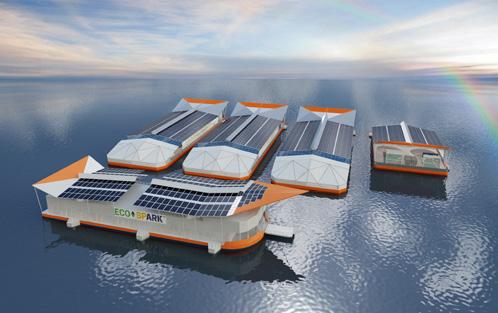
8 minute read
Innovations and startups making waves/Achieving food security
Innovations and startups making waves
Among the leading shrimp farming countries, it is none other than Indonesia where the conversation is on the adoption of Technology 4.0, which is considered an indispensable tool by industry players. Despite the slowdown with the Covid-19 pandemic, Dr Romi Novriadi, Vice President of the Indonesian Aquaculture Society or MAI, said that it is either staying with the traditional systems or adopt IR4.0 i.e. stay or move into the future. This is the country’s strategy to increase production volumes using the existing aquaculture areas. Indonesia has some early startups in aquaculture, such as eFishery, which is making waves in the aquaculture sector.(see page 62).
At the July International Forum of Science and Technology (FOSTECH) MAI webinar series on Smart Aquaculture for Farmers, Agus Somamihardja, Head, Indonesia Shrimp Hatchery Association pushed for scientific shrimp farming and data recording to monitor the pond’s water parameters. “Aquaculture is a complex activity, and farmers should view the pond in three dimensions instead of just one,” said Agus. “There is a need to have precision and increased accuracy; so that aquaculture can be a predictable activity. This can be achieved by adopting automation and removing the subjective elements in shrimp farming,” added Agus. A poll launched at the webinar showed that data recording was done manually on paper (38%), Excel spreadsheet (57%) or using a management system (4%).
BOSCH has entered the Indonesian market with AquaEasy, and Aries Dwiputera, Product Manager said that the goal is to transform shrimp farming from an art to a science. AquaEasy is a comprehensive artificial intelligence (AI) innovation to optimise shrimp culture. The development process began 3 years ago and today it encompasses disease and water quality management, and fills the gaps in the estimation of several parameters. It starts with sensors to get accurate, fast and reliable measurements of multiple water quality parameters for data analysis, and modelling to give insights into biomass estimation and growth anomalies. With cloud connectivity, production information is available in real-time and across all devices. The farmers get to know the crop status, whether it is optimal or below average. The system works on a subscription basis. Sensors can be located permanently in ponds or moved depending on the subscription level.
The World Bank has a series of webinars on the Internet of Things (IoT) for Agriculture . This initiative is supported by the Korea-World Bank Partnership Facility (KWPF), and in collaboration with USAID and Feed the Future, which is the US Government's global hunger and food security initiative. India’s Sreeram Raavi, Founder and Managing Director of Eruvaka Technologies was selected to present on “Transforming Aquaculture with IoT”. Eruvaka is already established in India, Central America and Ecuador, and has plans to expand into Indonesia, Malaysia and Vietnam with water quality monitoring, automated aerator control and on-demand intelligient feeding with acoustics integrated into a cloud-based software to provide insights on pond performance. Seeram explained the value chain integration– how Eruvaka’s data analysis of shrimp growth assesses post larvae batch performance and how this information can be filtered back to the hatchery to reflect on performance of broodstock. In the pond, real time feed consumption data show the health status of the stock and downstream, real time availability of shrimp biomass can be sent to prepare processing plants. The cost element to use these innovations is always a concern among farmers but Seeram pointed out that costs of his subscription-based business model is compensated by the savings in feeds (20%) and energy (~15%). Similar to several startups in shrimp farming, Eruvaka’s seamless integration of data contributes to risk mitigation for insurance purposes.
Next, Seeram plans to develop intelligent feed trays to assess shrimp growth and health, underwater drones to assess shrimp activity, and image processing-based feeders to access feed consumption by different fish species such as the tilapia. The latter is targeted for farms in Bangladesh, Vietnam and Indonesia.
At the August webinar on “Mariculture: The future of Asian Aquaculture”, organised by Infofish and sponsored by Skretting, USSEC’s Lan Hsiang-Pin expects that in the future, offshore aquaculture will be the mainstream culture system. Today, feeding is still manually done and new technologies such as image recognition and acoustic driven feeding will dramatically reduce feed conversion ratios. Joyce Leo, Marine Scientist at the Singapore-Japan deep tech startup UMITRON explained that the technology developed is aimed at increasing productivity in marine fish farming. There is the large smart automated feeder with feed management software and a feed silo of 400kg and another, without a feed silo for those farms already equipped with feed barges but is lacking in a centralised feed management software. How to accurately determine biomass in a cage remains a challenge and this is being resolved with underwater cameras measuring fish length. Next will be correlation of length and weight to have a more precise biomass data.
Achieving food security with innovation
In Singapore, aquaculture accelerator Hatch Blue organised a webinar series “Aquaculture Innovation Hour”. In the first conversation in June, Benedict Tan, Programme Coordinator at Hatch Blue led three panellists on entrepreneurship and innovation in food security. Georg Baunach, Managing Partner and Co-founder said that Hatch has a mission to support early stage startups in aquaculture. The accelerator works on innovations for aquaculture farms and in terms of traits, Georg said that there are two groups of innovators or startups. The first group consists of those who are very strong technically, often university-based but have a very poor understanding of the aquaculture markets. Hatch helps them understand more on the needs of these markets and how their innovation can fit in. The second group consists of those very well versed with their customers’ needs. In general, a positive attitude on solving challenges is a prerequisite for startups.
Benedict said that with empty shelves in supermarkets seen with the Covid-19 lockdown, food security has become a greater need as never before in Singapore. Singapore has the ‘30 by 30’ goal, that is, 30% local food production by 2030. This includes production of fish – but what will it take to get there?
Ah Hua Kelong has two farms and runs a seafood delivery business and a restaurant serving 90% locally produced seafood– farmed fish (mainly barramundi and groupers) and seafood from fisheries. For Wong Jing Kai, Managing Director, the opportunity to enter seafood marketing was the gap he saw; farmers are good at producing but have little knowhow on direct sales for their output. He started door to door deliveries of fresh locally produced seafood, selling fresh fish within 12 hours after harvesting.
There are varying perceptions on sustainability and Kai realises that it is here to stay, and he is seeking local certification on good farming practices. Georg complimented Kai’s entrepreneurial spirit which has brought him to this level today and mentioned how JALA, a startup in Indonesia, a member of Hatch Blue’s first cohort of startups, introduced sensors and software for massive improvements in feed conversion ratios in shrimp farms. He added that Norwegian farmers are highly optimised in salmon production and entrepreneurs in Singapore could also follow these examples to do the same and manage the resources better.
On achieving the ‘30 by 30’ goal, production is possible but Kai questioned whether the local market can absorb this increase in local production. Based on his experience in a shrimp farm in Malaysia, Ronnie Tan, aquaculture consultant, Malaysia, said that the critical factor is knowing the daily carrying capacity of the local market so as not to create a price turmoil in the market. Benedict summarised this conversation as the need to know economics and perception of the consumer, and not just performance and price.
In another Aquaculture Innovation Hour, the discussion was on encouraging a startup culture among the new generation of students. As Singapore’s aquaculture ecosystem is rather small for startups in aquaculture, Yeo Keng Joon, Chairman Bharat Luxindo Agrifeeds Pvt Ltd, an aquafeed company in Andhra Pradesh, India, proposed that an ideal option is to be involved in domestic fish production which will help the nation with sustained seafood production instead of dependence on imports. This is by using technologies for intensive systems such as recirculation aquaculture systems (RAS) or multitier farming concepts.
Agri-tech startup sells marine fish locally
Singapore's Aquaculture Centre of Excellence Pte Ltd (ACE®) has begun to revolutionise fish farming with an eco-friendly, cost effective and sustainable method. In May, in a live CNBC Squawk Box interview on his innovation Eco-Ark®, Leow Ban Tat, Founder/CEO outlined his role in Singapore’s long term strategy on food security in the aquaculture space. He is using his game-changing technology - a closed containment aquaculture system which is housed on a novel offshore advanced hull system (NOAHS) - as an alternative to open cage farming of marine fish.
“Technology can help to maximise production and is climate resilient and is not affected by poor quality water or harmful algae blooms. We have a close containment vertical farm; downwards to any ocean depth working with nature. We draw in seawater at very low energy and all other flow downstream is via gravity, thus saving energy, filtering and ozone sterilizing of the inlet water prior to use and treating outflow water before discharge back to the ocean. We add oxygen and create a cyclonic flow to raise fish in better conditions than in the wild. In such conditions the fish eat better, grow faster and have higher survival rates. We produce vaccine- and chemical- and hormone-free Asian seabass.”

ACE’s Eco Ark® integrates automated tank cleaning and feeder systems under one roof, creating an optimal environment for the production of healthy fish.
Leow emphasises on how future fish farming needs to evolve for self sustainability with cost efficiency and yet not pollute the sea in Singapore. ACE expects to produce 166 tonnes of fish by 2021, which is 20X more than a coastal fish farm. Today, ACE has a B to C business model and is working with a large supermarket chain and online sales at ace-fishmarket.com. There is a better value in terms of carbon footprint to export this patented technology for aquaculture 4.0 rather than export frozen fish.




